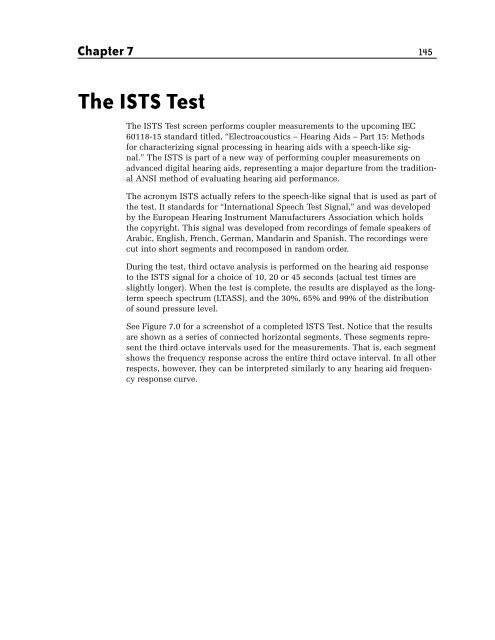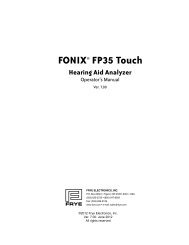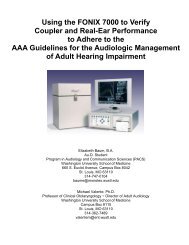FONIX® 8000 - Frye Electronics
FONIX® 8000 - Frye Electronics
FONIX® 8000 - Frye Electronics
You also want an ePaper? Increase the reach of your titles
YUMPU automatically turns print PDFs into web optimized ePapers that Google loves.
Chapter 7 145<br />
The ISTS Test<br />
The ISTS Test screen performs coupler measurements to the upcoming IEC<br />
60118-15 standard titled, “Electroacoustics – Hearing Aids – Part 15: Methods<br />
for characterizing signal processing in hearing aids with a speech-like signal.”<br />
The ISTS is part of a new way of performing coupler measurements on<br />
advanced digital hearing aids, representing a major departure from the traditional<br />
ANSI method of evaluating hearing aid performance.<br />
The acronym ISTS actually refers to the speech-like signal that is used as part of<br />
the test. It standards for “International Speech Test Signal,” and was developed<br />
by the European Hearing Instrument Manufacturers Association which holds<br />
the copyright. This signal was developed from recordings of female speakers of<br />
Arabic, English, French, German, Mandarin and Spanish. The recordings were<br />
cut into short segments and recomposed in random order.<br />
During the test, third octave analysis is performed on the hearing aid response<br />
to the ISTS signal for a choice of 10, 20 or 45 seconds (actual test times are<br />
slightly longer). When the test is complete, the results are displayed as the longterm<br />
speech spectrum (LTASS), and the 30%, 65% and 99% of the distribution<br />
of sound pressure level.<br />
See Figure 7.0 for a screenshot of a completed ISTS Test. Notice that the results<br />
are shown as a series of connected horizontal segments. These segments represent<br />
the third octave intervals used for the measurements. That is, each segment<br />
shows the frequency response across the entire third octave interval. In all other<br />
respects, however, they can be interpreted similarly to any hearing aid frequency<br />
response curve.
















